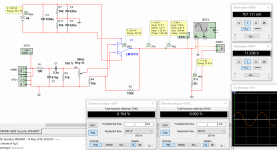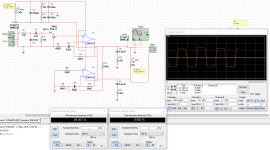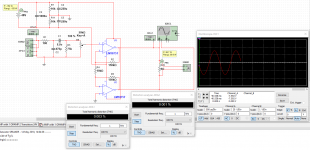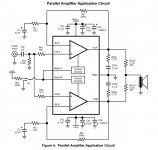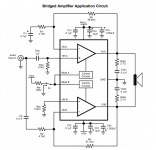I know this is a weird and probably a stupid question, but I really wondered that if we can get a 70W output from 2 TDA2050's.
I have some speakers. Not very good ones, but they are 'kinda' good. Their amp just died after 35 years of usage, and I decided to build a new one.
The amp doesn't need to be very complicated or the most Hi-Fi or something. It just needs to deliver 60-70 watts to 4 Ohms without exceeding 1% THD.
So, the easiest solution was to use an integrated power amplifier, but as I can see, they are not giving much power. I'm open to every idea.
I'm attaching a sample circuit. I've used LM1875T instead of TDA2050 because Multisim doesn't have that model.
Thank you.
I have some speakers. Not very good ones, but they are 'kinda' good. Their amp just died after 35 years of usage, and I decided to build a new one.
The amp doesn't need to be very complicated or the most Hi-Fi or something. It just needs to deliver 60-70 watts to 4 Ohms without exceeding 1% THD.
So, the easiest solution was to use an integrated power amplifier, but as I can see, they are not giving much power. I'm open to every idea.
I'm attaching a sample circuit. I've used LM1875T instead of TDA2050 because Multisim doesn't have that model.
Thank you.
Attachments
You would need to bridge them. You would need a phase splitter on the front
end to put different phases into the two amps. The load would need to be
8 ohms in bridged mode.
Yes, that will quadruple the output power to 140W, because the output voltage is doubled.
This only works with a load of 8 ohms, since each half of the bridge sees 4 ohms.
Yes, that will quadruple the output power to 140W, because the output voltage is doubled.
This only works with a load of 8 ohms, since each half of the bridge sees 4 ohms.
My impression is, unfortunately, not up to 140W. You will run into the current limit of 5A (peak) for the amplifier. Even in 8 Ohm you may get close to 100W, not more.
Or use this schematicYou would need a phase splitter on the front end to put different phases into the two amps.

You would need to bridge them.
You would need a phase splitter on the front end to put different phases into the two amps.
The load would need to be 8 ohms in bridged mode.
Thank you for the response. I didn't wanted to reply until I get it right. I've been doing my research. Tried to use a NPN transistor as a phase splitter. Didn't do well. Also tried to use a differential amplifier as a splitter. I messed that up too. I even tried to use a Class AB amplifier and use its push-pull mechanism to get that split. Didn't work.
If you have a simple example I would appreciate that. I'm not going to use it directly, just to get the idea of how to do that.
Or use this schematic

Thank you for the schematic. I've just tried to build that with LM1875T (basically the same thing) but unfortunately it didn't work. It's giving that 70W but it's also clipping. I've attached the results.
Attachments
Use 2x22V.
I've even tried 2x48V. Unfortunately it's always clipping.
Looks like you are getting a max of about 13V on each half bridge before current limiting. 13V/4ohm = 3.25A
LM1875 has a current limit around 4A with only the guarantee of 3A (see tested limits http://www.ti.com/lit/ds/symlink/lm1875.pdf) so the sim is about right. If you back off the input amplitude so it is at the onset of clipping you are getting about 42watts.
LM1875 has a current limit around 4A with only the guarantee of 3A (see tested limits http://www.ti.com/lit/ds/symlink/lm1875.pdf) so the sim is about right. If you back off the input amplitude so it is at the onset of clipping you are getting about 42watts.
Last edited:
???
The maximum is 2x25V.
According to datasheet it can deliver 28W 4 ohms with 2x22V at 0,5% and 35W at 10%.
So can deliver around 60W 8 ohms bridged.
In Multisim I think there is no voltage limit. It lets you increase it to any point you like. But in real life, it would explode I think.
I've tempered with the values and the design a little bit. I think it's working. At least for 8 Ohms. My speakers are 6 Ohms, so it'll still be clipping a little.

Looks like you are getting a max of about 13V on each half bridge before current limiting. 13V/4ohm = 3.25A
LM1875 has a current limit around 4A with only the guarantee of 3A (see tested limits http://www.ti.com/lit/ds/symlink/lm1875.pdf) so the sim is about right. If you back off the input amplitude so it is at the onset of clipping you are getting about 42watts.
Makes sense. So these circuits do have current limits. Hmm. Does that mean that I can add a class AB amplifier to increase the current. But at the end I wouldn't be able to cool everything down. Even TDA2050 will burn like hell with a heatsink and 2 transistors. Whoa. That's not a good idea.
Attachments
Everybody is suggesting bridging an already abused amplifier which can´t cope with the load even direct driving it ; bridging only complicates matters and in any case will solve nothing.
To the OP: PLEASE confirm or deny:
Thanks.
Plan B:
Or straight use LM3886/TDA7294 which are adequately rated to provide 50 to 80W RMS with no problems or complications, instead of trying to squeeze blood out of poor TDA2050; excellent amps but rated much lower.
To boot, TDA2050 is out of production for 1 or 2 years now, all known good ones were swept from dealer´s shelves (I got about 200 of them, all that was available at the Importer´s warehouse) and today what´s easily available is a FAKE one, normally a rebranded TDA2030 .
Just sayin´
To the OP: PLEASE confirm or deny:
Proper answer depends FULLY on that.It just needs to deliver 60-70 watts to ***4 Ohms***
Thanks.
Plan B:
Or straight use LM3886/TDA7294 which are adequately rated to provide 50 to 80W RMS with no problems or complications, instead of trying to squeeze blood out of poor TDA2050; excellent amps but rated much lower.
To boot, TDA2050 is out of production for 1 or 2 years now, all known good ones were swept from dealer´s shelves (I got about 200 of them, all that was available at the Importer´s warehouse) and today what´s easily available is a FAKE one, normally a rebranded TDA2030 .
Just sayin´
Everybody is suggesting bridging an already abused amplifier which can´t cope with the load even direct driving it ; bridging only complicates matters and in any case will solve nothing.
To the OP: PLEASE confirm or deny:
Proper answer depends FULLY on that.
Thanks.
Plan B:
Or straight use LM3886/TDA7294 which are adequately rated to provide 50 to 80W RMS with no problems or complications, instead of trying to squeeze blood out of poor TDA2050; excellent amps but rated much lower.
To boot, TDA2050 is out of production for 1 or 2 years now, all known good ones were swept from dealer´s shelves (I got about 200 of them, all that was available at the Importer´s warehouse) and today what´s easily available is a FAKE one, normally a rebranded TDA2030 .
Just sayin´
Oh, I didn't know there was something rated that high. I should use one or two of those TDA7294's. I wish it had a Multisim model. But I think I can use LM3875TF as a reference.

My old amplifier gave 80W @ 4 Ohms but my speakers are 6 Ohms.
I've never used them near 100%, so it doesn't need that 80W. Even 50W or 60W is enough.
If you have an AC meter, or can borrow one - it's easy to figure out how much voltage you need to run your speakers. From that you can easily calculate power and current. Voltage is the important measure. That will help you know how much amplifier you need not to clip the signal. Click to the thread in my sig line below.
If you have an AC meter, or can borrow one - it's easy to figure out how much voltage you need to run your speakers. From that you can easily calculate power and current. Voltage is the important measure. That will help you know how much amplifier you need not to clip the signal. Click to the thread in my sig line below.
My amp is unfortunately dead. I don't think I can do that. But after I build something that can drive the speakers, that's something I'll definitely try.
The PS is wrong. Replace it with two DC voltages with a ground connection where they join together.
I think there is no difference between but, thank you. I was thinking about buying a 48V supply. They are expensive. Now, after reading your post, I remembered that I can get two 24V instead. They are very much cheaper.
edit: Oh, I forgot to ask. Should I connect the ground to the 'real' ground? I mean the power socket ground?
Last edited:
For the SIM it doesn't matter if you connect ground to PE.
It doesn't work properly constructing the PSU the way you have done. Check how the voltage changes when you increase the output current.
If you really want 70 watts / 4 ohm you will need 6 to 8 IC configured bridged parallel with a 200 W transformer and a lot of capacitors.
It doesn't work properly constructing the PSU the way you have done. Check how the voltage changes when you increase the output current.
If you really want 70 watts / 4 ohm you will need 6 to 8 IC configured bridged parallel with a 200 W transformer and a lot of capacitors.
For the SIM it doesn't matter if you connect ground to PE.
It doesn't work properly constructing the PSU the way you have done. Check how the voltage changes when you increase the output current.
If you really want 70 watts / 4 ohm you will need 6 to 8 IC configured bridged parallel with a 200 W transformer and a lot of capacitors.
Oh. I get it. Thank you.
I meant in real life. When I build any audio equipment. Should I connect ground to the power-socket ground? Will it be fine, or is it going to be noisy or something?

More important than the current limit of the LM1875 is the thermal limit when bridged.
You might want to try the LM4780 which is EOL but readily available. (I have four tubes of them!) The chip can be bridged or paralleled -- for your application parallel would seem ideal:
You might want to try the LM4780 which is EOL but readily available. (I have four tubes of them!) The chip can be bridged or paralleled -- for your application parallel would seem ideal:
Attachments
- Status
- This old topic is closed. If you want to reopen this topic, contact a moderator using the "Report Post" button.
- Home
- Amplifiers
- Chip Amps
- Can I get 70W from two 35W amplifiers?
